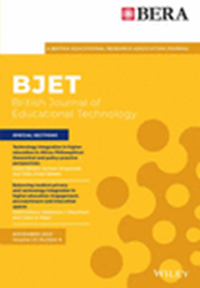Use of human–computer interactive games for the dynamic assessment of language skills of children with autism spectrum disorder
Abstract
This study explored the influence of the dynamic assessment of human–computer interactive games on children's language potential. Thirty-seven special children aged 3–7 years were selected to participate in the study. They were divided into three groups according to their scores on the Autism Behaviour Checklist: (1) a non-autism group, (2) a suspected autism group and (3) an autism group. In two stages of static and dynamic assessment, all three groups of children completed language tests under the conditions of no mediated prompt and mediated prompts, and the data generated in the game interactions were processed and analysed. The findings suggest the following: (1) static assessment may ignore children's language potential, while dynamic assessment can measure and differentiate children's potential language development ability; (2) children with ASD need more mediation prompts and are more likely to complete tasks with explicit mediation prompts; (3) children with ASD have weaker language potential, and children with suspected ASD or non-ASD children have homogeneous language potential; and (4) assessors should pay timely attention to and maintain children's learning status and psychological changes. This study demonstrates the importance of human–computer interactive games as a dynamic assessment tool to tap into children's language potential and to determine their proximal developmental zone, which has important implications for teachers in understanding groups with different language abilities.
Practitioner notes
What is already known about the topic?
- The traditional language assessment paradigm (static assessment) can only evaluate the learners' current language development ability, while the short-term development potential may not be observed.
- Different prompts in the mediation strategy can be used as a quantitative assessment paradigm in dynamic assessment.
- Much of the dynamic assessment in children with ASD focuses on language vocabulary learning outcomes and lacks measurement or quantification of language potential.
What this paper adds?
- Presents a method for the dynamic assessment of a human–computer interactive language game suitable for children aged 3–7 years with ASD.
- Quantifies the potential level of language skills in children with varying degrees of ASD.
- Objectively and dynamically compares differences in language development potential between different groups.
- In dynamic assessment, children's learning status and psychological changes should be paid attention to and maintained in time.
Implications for practice, research or policy
- This paper provides a concrete example of how human–computer interactive games can be used to dynamically assess the language potential of children with ASD.
- These findings highlight the importance of progressive scaffolds (mediated prompts) in children's language learning, which can help children identify and solve problems in a timely manner.
- For educational developers, language intervention materials should be prepared in a way that encompasses the different levels of language skills of children with different disabilities, that is, within the individual's zone of proximal development.

 求助内容:
求助内容: 应助结果提醒方式:
应助结果提醒方式:


